
Second edition in motion
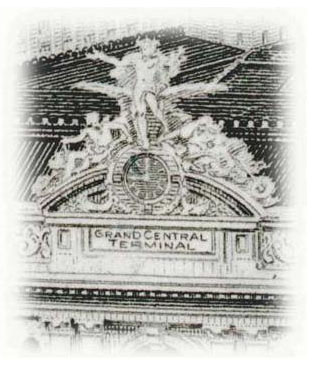 The clock atop Grand Central Station reads 9:00 am.
The clock atop Grand Central Station reads 9:00 am.
The second edition is NOT out yet. But, at least things are progressing. Because of family health problems, the publisher was unable to meet the February deadline in time for Smythe’s stock and bond show at Strasburg, PA.
The upside of that delay is that more advertisers signed up, thereby lowering the price of the book.
The book will be contain almost twice as many pages as the first edition. Currently, the plans are to publish the book in at least two different forms.
The primary form will be a spiral bound edition. The binding will be a crush-resistant plastic coil, not steel. This binding will be a little more expensive, but it will allow the book to lay flat when opened. I was not a fan of spiral binding, but having used it, I think it will work well.
The publisher also plans to print a special hardbound version. That binding appeals to people like me who like books. But, it will not be as appropriate for carrying to shows.
The publisher now plans to have the book available by mid-April and into the hands of dealers quickly thereafter. Please check my web site periodically. I will post an announcement there just as soon as I learn of the exact publish date. I will also try to post a list of all the dealers who will be selling the book.
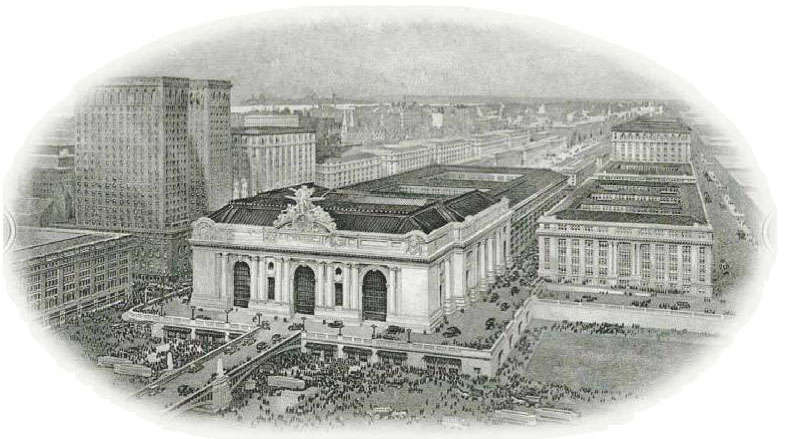 Grand Central Terminal, built 1913 in New York City to replace the earlier Grand Central Depot. This superb vignette was engraved by American Bank Note Company. It appears on several series of New York Central Railroad Co. bonds and shows streetcars, horse-drawn freight wagons, early autos, and hundreds of people.
Grand Central Terminal, built 1913 in New York City to replace the earlier Grand Central Depot. This superb vignette was engraved by American Bank Note Company. It appears on several series of New York Central Railroad Co. bonds and shows streetcars, horse-drawn freight wagons, early autos, and hundreds of people.
428 New Certificates Since September
|
1st Edition |
Last Issue |
Currently |
| Number of certificates listed (counting all variants of issued, specimens, etc.) |
8,559 |
17,369 |
17,797 |
| Number of distinct certificates known |
7,152 |
13,360 |
13,657 |
| Number of certificates with celebrity autographs |
699 |
1,376 |
1,399 |
| Number of celebrity autographs known |
232 |
317 |
320 |
| Number of railroads and railroad-related companies known |
17,276 |
23,576 |
23,600 |
| Number of companies for which at least one certificate is known |
3,516 |
5,733 |
5,834 |
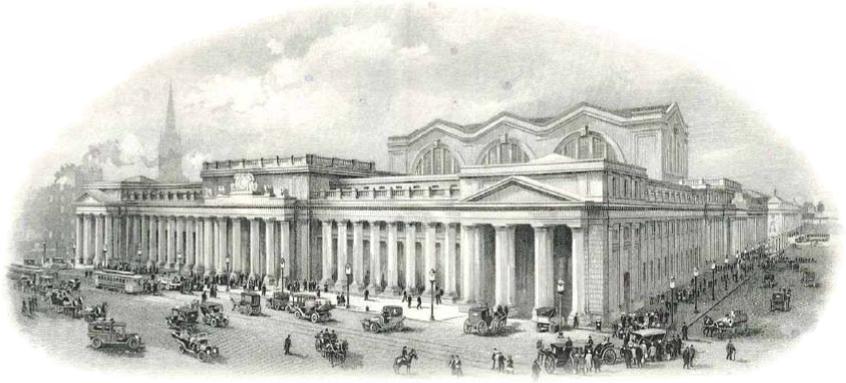
New York’s Penn Station, erected in 1910. This image by American Bank Note Company appears on several series of Pennsylvania Railroad Co. certificates after about 1915. The building was demolished in 1963 to make way for Madison Square Garden.
Miscellaneous messages
Rate of New Additions. New certificates continue to come in at a fast rate, although they have slowed some. Many new certificates are coming from the internet, specifically online auctions and catalogs.
Current Price Activity. Several dealers have asked what I think is happening with prices right now. I do not claim to have a definitive answer, but, from here, it looks like prices for very common items are relatively stable. Prices for hoard items remain very low. It appears that demand for very high-ticket items might be down a little, but not tremendously. In fact, I have seen a few certificates sold recently for surprisingly high prices. It looks to me that, if there is any softness in prices and action, it is in the middle-price material, say the $50 to $300 range. I get the impression in talking with people that advanced collectors already own that kind of material and beginners are reluctant to move into that stage.
Having said that, I know several of my regular correspondents are quietly grabbing intriguing material few other people seem to have noticed. Many of those certificates are scarce to very rare. Since many of those certificates lack stunning eye appeal, they are getting them for affordable prices.
In these times when people perceive the market to be soft, or even dead, observant collectors are substantially adding to their collections from several sources.
Certificates for sale Ebay. Ebay is re-shaping the dealer market. Several dealers have complained to me how online auctions are killing them. Others are selling a lot of material there. If you are a collector, you really need to be aware of the certificates being sold there.
Ebay attracts many beginners, so selling high-ticket rarities takes persistence. Certainly, a number of prominent dealers (David Beach, Bob Kerstein, Scott Winslow, Ken Holter, Mauro Magnani, Steve Schweikhart, Clinton Hollins, George LaBarre, Mario Boone, and a host of others) have discovered a way to take advantage of Ebay and the internet. If you are a seller, you may want to re-investigate this venue.
Ebay University. Whether you’re professional or casual, I give my highest possible recommendation that you attend an Ebay University seminar if one is ever in your area. Your tiny investment in time will prove hugely beneficial, whether you’re buying or selling. Check “Community > Events” on Ebay for schedules.
European Ebay. If you live in Europe, check local Ebay sites for Belgium, France, Germany, Italy, United Kingdom, and other countries. Be aware that the items you see on one Ebay site are NOT necessarily the same ones that appear on others. In fact, the stocks and bonds you see in Europe are often very different from the ones you will see in the U.S. By shopping several sites, collectors can grab interesting and scarce items that they may not normally see. And now that Paypal has instituted cross-currency transfers, buying and selling is finally getting easier.
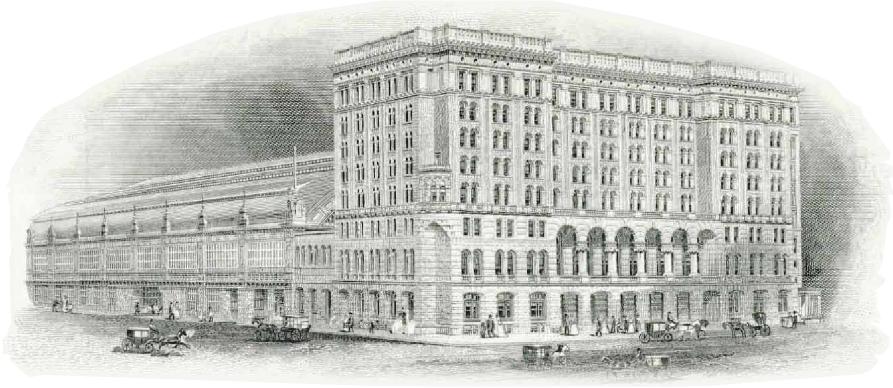
American Bank Note Company vignette of Philadelphia’s prominent 8-story Reading Terminal Headhouse. The Reading Railroad built the structure in 1888. Renovation began in 1993 and the building (minus the train shed) survives as part of the Pennsylvania Convention Center. In the foreground are five horsedrawn carriages.
Paypal. Sellers, make sure you accept Paypal. I cannot stress this enough. Many collectors tell me that they avoid buying, or purposely underbid on, items when sellers do not accept Paypal.
Buyers, make sure you sign up to pay through Paypal. You will get your items a lot quicker and with a lot less hassle.
(I sell newspapers, magazines, and collectible paper on Ebay, and I receive almost three-quarters of my payments through Paypal.)
Removal of Some Companies From the Database. Over the years, I added several hundred companies that were indirectly related to railroading. As the numbers of companies mounted, more and more companies had less and less to do with railroading.
The problem was not the database. It was my lack of time. It was getting to the point where it was taking too much time to track the prices of certificates at the “edges” of my specialty. I needed to re-focus on the “center” of my specialty, which is railroading.
Before I finalized the second edition, I asked my primary contributors what they thought about removing about a couple hundred companies. My problem companies comprised several categories including tunneling, bridges, construction, manufacturing, utilities, and real estate.
Respondents generally agreed with dumping companies not directly related to railroading. Some even applauded the decision. The only major disagreement was the argument to keep the major bridge companies that are normally sold as railroads. (I kept them.)
I apologize if I offended anyone by taking such a pragmatic approach. I wish I had more time. Unfortunately, tracking and pricing certificates from peripheral companies had become truly burdensome.
Logging and Lumber Companies. For my part, I insisted on keeping logging, lumber, timber, and plantation companies that I know ran railroads. Those companies did not make their profits from railroading, but railroading was a crucial part of their operations. Most could not have operated without their private railroads. A few ultimately achieved common-carrier status and many became parts of larger railroads. Locomotive and rolling stock rosters show the tremendous amount of equipment that those companies used.
Arguably, at some point in the future, it may become necessary to separate logging companies from the database. For now, I will include those companies.
My Role in the Hobby. I see my role as nothing more than informational middleman. I love the hobby and I love certificates, but my passion is organizing information. I repackage information and give it away. Which means that if you want to keep secret information, don’t tell me.
I am absolutely serious about this. I believe that, as collectors, we owe a huge debt to every collector who has gone before us. The only way to re-pay that debt is by leaving our knowledge for those who follow us. In my view, free and open knowledge is the lifeblood of our hobby.
Major Printing Companies
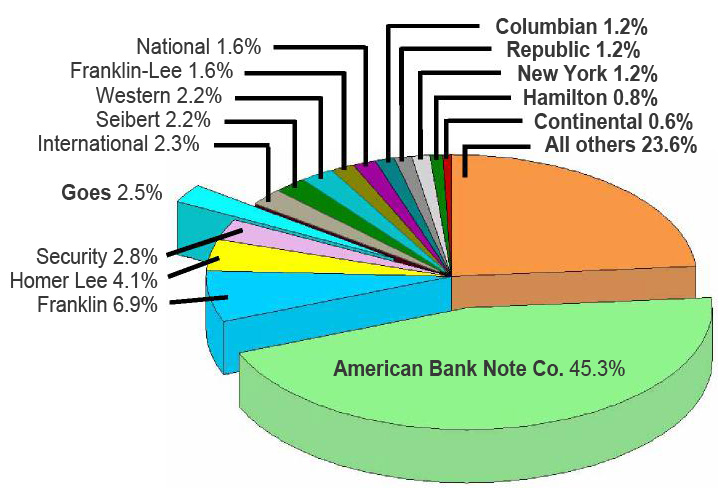
While we have only identified the printers on about half the known varieties of stocks and bonds, we are finally able to see patterns emerge. Not surprisingly, American Bank Note Company is the major printer. Alone, ABNCo printed almost as many varieties as all the other printers combined.
As we gain more knowledge, I suspect the relative order among the major bank note companies will not change much.
With one exception.
Ultimately, I suspect Goes Lithographic Co. to move up into fourth, maybe even third, place in a few years. Printers have not yet been identified for many generic certificates. Just by looking, though, I can tell that most are Goes’ products.
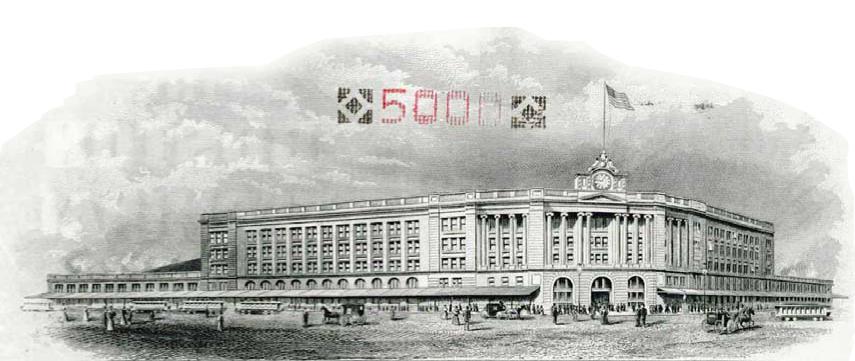 The Boston & Albany Railroad Co. completed Boston’s South Union Terminal in 1899. It became more popularly known as South Station. Visible at the rear of the building (left side) is its huge train shed, once the largest in the world. Because of deterioration, the shed was removed in 1930. Parts of the remaining building were renovated in the 1980s and South Station survives as part of Boston’s regional transportation system. This vignette, by American Bank Note Company, is found on Boston Terminal Company bonds.
The Boston & Albany Railroad Co. completed Boston’s South Union Terminal in 1899. It became more popularly known as South Station. Visible at the rear of the building (left side) is its huge train shed, once the largest in the world. Because of deterioration, the shed was removed in 1930. Parts of the remaining building were renovated in the 1980s and South Station survives as part of Boston’s regional transportation system. This vignette, by American Bank Note Company, is found on Boston Terminal Company bonds.